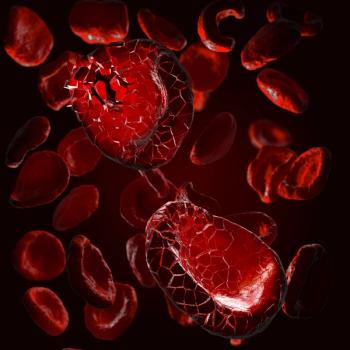
Oncology NEWS International
- Oncology NEWS International Vol 16 No 6
- Volume 16
- Issue 6
Meta-Analysis Shows Rituximab-Chemo Increases Overall Survival in Indolent/Mantle Cell Lymphoma
Adding the anti-CD20 monoclonal antibody rituximab (Rituxan) to chemotherapy (R-chemo) achieved better overall survival rates than chemotherapy alone for patients with advanced indolent or mantle cell lymphoma, according to a recent meta-analysis.
COLOGNE, Germany-Adding the anti-CD20 monoclonal antibody rituximab (Rituxan) to chemotherapy (R-chemo) achieved better overall survival rates than chemotherapy alone for patients with advanced indolent or mantle cell lymphoma, according to a recent meta-analysis. The R-chemo patients also exhibited better overall response, complete response, and disease control.
Holger Schulz, MD, of the University of Cologne, and his colleagues conducted a meta-analysis of seven randomized, controlled clinical trials involving 1,943 adult patients. The results allowed them to conclude that "concomitant treatment with rituximab and standard chemotherapy regimens should be considered the standard of care for patients with indolent and mantle cell lymphomas who require therapy and for patients with follicular lymphoma" (J Natl Cancer Inst 99:706-714, 2007).
In the seven trials, published from 1990 to 2005, patients with advanced indolent lymphoma and mantle cell lymphoma were randomized to receive either R-chemo or chemotherapy alone. The study excluded ongoing studies, interim analyses, nonrandomized studies, and studies with 10 or fewer patients per study arm. Also excluded were studies involving patients with HIV or primary CNS lymphoma.
Among the patients in the seven studies, 1,480 had histologically proven follicular lymphoma; 260 had mantle cell lymphoma; and 203 were described as having indolent lymphoma (121) or lymphoplasmocytic/cytoid lymphoma or B-cell chronic lymphocytic leukemia (82). Five trials included untreated patients with advanced disease, and two trials included relapsed or refractory patients with follicular or mantle cell histology.
Various chemotherapy regimens were used in the trials, which precluded a reliable assessment of which chemotherapy regimen is best when used in combination with rituximab, or of the optimal number of cycles needed to treat patients with indolent lymphoma.
Toxicity in the studies was described as mild to moderate in each arm, but those receiving R-chemo were significantly more likely to have fever and leukocytopenia than those treated only with chemotherapy. There was no difference between groups with respect to frequencies of infection or thrombocytopenia.
Data from 1,914 available patients were analyzed for overall response. Among these patients with either indolent lymphoma or mantle cell lymphoma, 854 of 979 patients (87%) in the R-chemo group responded to treatment vs 673 of 935 patients (72%) in the chemotherapy-alone group-corresponding to a relative risk (RR) of response of 1.21 for the treatment group. The rate of complete response was significantly higher in patients treated with R-chemo (RR = 2.03). Analyses for disease control determined that R-chemo had a pooled hazard ratio of 0.62, which was significantly superior to chemotherapy alone.
Using overall survival data for all 1,943 patients, who were observed from 18 to 39 months, depending on the study (median, 24 months), the researchers found a hazard ratio (HR) for death from any cause of 0.65-a "statistically significantly better overall survival in the R-chemo group, compared with the chemotherapy-alone group," they wrote.
Subgroup Analyses
Dr. Schultz and his colleagues included 1,480 patients from five studies in a subgroup analysis of overall survival in follicular lymphoma. Of these patients, 97 of 759 (13%) died after treatment with R-chemo vs 142 of 721 (20%) after chemotherapy alone. This indicated significantly better overall survival in the R-chemo group than in the chemotherapy-alone group (HR for mortality = 0.63). "Assuming a 2-year overall survival rate of 90% for patients with follicular lymphoma and the estimated HR of 0.63, the number of patients who would need to be treated with R-chemo to prevent one additional death in 2 years was 28," the authors said.
A subgroup analysis of patients with mantle cell lymphoma included three trials with a total of 260 patients; it showed an overall survival advantage for R-chemo, compared with chemotherapy alone (HR for mortality = 0.60). "However, there was heterogeneity among the trials (P = .07), making the survival benefit less reliable," Dr. Schulz said.
"This meta-analysis demonstrated that in patients with indolent or mantle cell lymphoma, R-chemo is superior to chemotherapy alone with respect to remission, induction, progression-free survival, and overall survival," the authors concluded. One of the most important open questions for patients with indolent non-Hodgkin's lymphoma, they said, is "the impact of maintenance treatment with rituximab on overall survival."
Articles in this issue
over 18 years ago
ACS Launches Major Epidemiology Studyover 18 years ago
Pt Selection Key to Radioembolization of Liver Ca'sover 18 years ago
Million Dollar Gotham Prize Announcedover 18 years ago
Diagnostic Dilemma: GI Diseaseover 18 years ago
Junovan Fails to Win ODAC Nod for Osteosarcoma Treatmentover 18 years ago
Surveillance Colonoscopy Guidelines Not Being Followedover 18 years ago
Removing Stage IV Primary May Cut Mortalityover 18 years ago
Nuclear Export Inhibitors Testing Moving Forwardover 18 years ago
ODAC: orBec Yields No 'Substantial Efficacy' in GI GVHDNewsletter
Stay up to date on recent advances in the multidisciplinary approach to cancer.
















































































